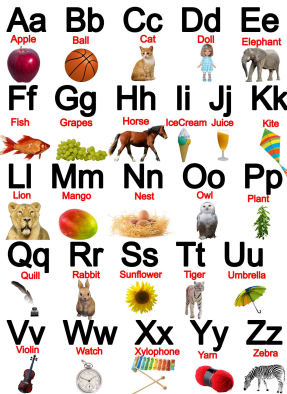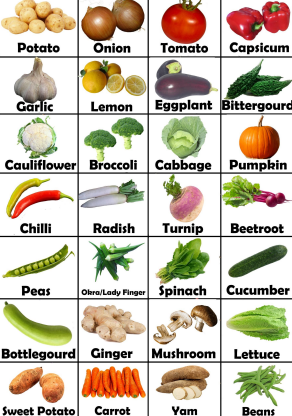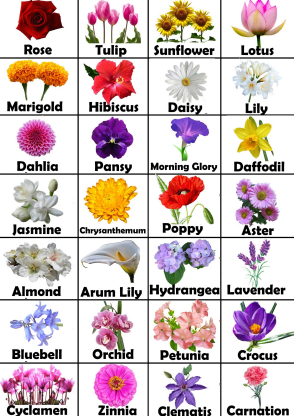ABC chart for preschool kids, useful for identification of alphabets and basic words by linking with things.
Download ABC Chart here
Numbers chart from 1 to 10 with illustrations that help the kid count.
Download Numbers chart here
Learning about vegetables can be fun and educational! You can show the chart and teach the following about each vegetable:1. **Name**: The name of the vegetable.
2. **Color**: The color of the vegetable.
3. **Taste**: A description of the taste (e.g., sweet, bitter, spicy).
4. **Nutrients**: The nutrients found in the vegetable (e.g., vitamin A, vitamin C, fiber).
5. **How to Eat**: Different ways to prepare or eat the vegetable (e.g., raw, cooked, in salads).
6. **Fun Fact**: An interesting fact about the vegetable.
This activity can help children learn about different vegetables, their nutritional value, and how they can be incorporated into a healthy diet.
Download Vegetables chart here
Similar to vegetables you can do the same activity for fruits by showing the chart.
1. **Name**: The name of the fruit.
2. **Color**: The color of the fruit.
3. **Taste**: A description of the taste (e.g., sweet, sour, juicy).
4. **Nutrients**: The nutrients found in the fruit (e.g., vitamin C, fiber, potassium).
5. **How to Eat**: Different ways to prepare or eat the fruit (e.g., peeled, sliced, in smoothies).
6. **Fun Fact**: An interesting fact about the fruit.
This activity can help children learn about different fruits, their nutritional value, and how they can be part of a healthy diet.
1. **Name**: The name of the fruit.
2. **Color**: The color of the fruit.
3. **Taste**: A description of the taste (e.g., sweet, sour, juicy).
4. **Nutrients**: The nutrients found in the fruit (e.g., vitamin C, fiber, potassium).
5. **How to Eat**: Different ways to prepare or eat the fruit (e.g., peeled, sliced, in smoothies).
6. **Fun Fact**: An interesting fact about the fruit.
This activity can help children learn about different fruits, their nutritional value, and how they can be part of a healthy diet.
Download Fruits Chart here
Bird chart for learning can be a great way to introduce children to the fascinating world of birds. You can discuss the following details while showing the picture of the bird:
1. **Name**: The name of the bird.
2. **Color**: The predominant colors of the bird's feathers.
3. **Size**: The approximate size of the bird (e.g., small, medium, large).
4. **Habitat**: The type of environment where the bird is usually found (e.g., forest, wetlands, urban areas).
5. **Diet**: What the bird eats (e.g., seeds, insects, fish).
6. **Nesting**: How the bird builds its nest and where it nests (e.g., in trees, on the ground).
7. **Interesting Fact**: An interesting or unique fact about the bird.
This activity can help children learn about different bird species, their habitats, and their behaviors.
1. **Name**: The name of the bird.
2. **Color**: The predominant colors of the bird's feathers.
3. **Size**: The approximate size of the bird (e.g., small, medium, large).
4. **Habitat**: The type of environment where the bird is usually found (e.g., forest, wetlands, urban areas).
5. **Diet**: What the bird eats (e.g., seeds, insects, fish).
6. **Nesting**: How the bird builds its nest and where it nests (e.g., in trees, on the ground).
7. **Interesting Fact**: An interesting or unique fact about the bird.
This activity can help children learn about different bird species, their habitats, and their behaviors.
Download Birds Chart here
Flower chart can be a fun way to introduce children to the world of flowers. Discuss the following while showing the flower images.
1. **Name**: The name of the flower.
2. **Color**: The color(s) of the flower.
3. **Shape**: The shape of the flower (e.g., round, star-shaped).
4. **Fragrance**: Whether the flower has a fragrance and how it is described (e.g., sweet, spicy).
5. **Blooming Season**: When the flower typically blooms (e.g., spring, summer, year-round).
6. **Uses**: Any practical or cultural uses of the flower (e.g., medicinal, decorative).
7. **Interesting Fact**: An interesting or unique fact about the flower.
This activity can help children learn about different flowers, their characteristics, and their significance in various cultures and environments.
1. **Name**: The name of the flower.
2. **Color**: The color(s) of the flower.
3. **Shape**: The shape of the flower (e.g., round, star-shaped).
4. **Fragrance**: Whether the flower has a fragrance and how it is described (e.g., sweet, spicy).
5. **Blooming Season**: When the flower typically blooms (e.g., spring, summer, year-round).
6. **Uses**: Any practical or cultural uses of the flower (e.g., medicinal, decorative).
7. **Interesting Fact**: An interesting or unique fact about the flower.
This activity can help children learn about different flowers, their characteristics, and their significance in various cultures and environments.
Download Flowers chart here
Educational chart about wild animals can be both informative and engaging for children. Discuss the features below while showing the animal pictures:
1. **Name**: The name of the animal.
2. **Habitat**: The natural environment where the animal lives (e.g., forest, savanna, ocean).
3. **Diet**: What the animal eats (e.g., herbivore, carnivore, omnivore).
4. **Size**: The approximate size of the animal (e.g., small, medium, large).
5. **Lifespan**: How long the animal typically lives.
6. **Predators**: Animals that prey on this animal.
7. **Interesting Fact**: A fun or unique fact about the animal.
This activity can help children learn about different wild animals, their habitats, and their characteristics.
1. **Name**: The name of the animal.
2. **Habitat**: The natural environment where the animal lives (e.g., forest, savanna, ocean).
3. **Diet**: What the animal eats (e.g., herbivore, carnivore, omnivore).
4. **Size**: The approximate size of the animal (e.g., small, medium, large).
5. **Lifespan**: How long the animal typically lives.
6. **Predators**: Animals that prey on this animal.
7. **Interesting Fact**: A fun or unique fact about the animal.
This activity can help children learn about different wild animals, their habitats, and their characteristics.
Download Wild Animals Chart here
An educational chart about modes of transport can be a great way to introduce children to various ways people and goods travel. Discuss the below points while showing the images of the chart.1. **Name**: The name of the mode of transport.
2. **Type**: Whether it's land, water, air, or a combination.
3. **Speed**: The typical speed of the mode of transport (e.g., slow, medium, fast).
4. **Capacity**: How many people or how much cargo it can carry.
5. **Examples**: Some common examples of this mode of transport.
6. **Advantages**: The benefits of using this mode of transport.
7. **Disadvantages**: The drawbacks or limitations of this mode of transport.
This activity can help children learn about different modes of transport, how they work, and when they might be used.
Download Modes of Transport chart here
An educational chart about the parts of the body can help children learn about anatomy. You can discuss the following by showing the chart:1. **Head**: Includes the eyes, ears, nose, mouth, and hair.
2. **Neck**: Connects the head to the body.
3. **Shoulders**: Connects the arms to the body.
4. **Arms**: Include the upper arm, elbow, forearm, wrist, and hand.
5. **Chest**: The front of the body between the neck and abdomen.
6. **Abdomen**: The area below the chest, containing the stomach and other organs.
7. **Back**: The rear part of the body, from the shoulders to the waist.
8. **Hips**: Connect the legs to the body.
9. **Legs**: Include the thigh, knee, calf, ankle, and foot.
10. **Feet**: Include the toes and the sole of the foot.
This activity can help children learn about their bodies and how different parts function.
Download Parts of Body Chart here
You can further use days of the week, months of the year and basic shapes to teach the kids.









Urdu Alphabets
ReplyDeleteThanks for visiting our site, do share it with your friends!
Delete